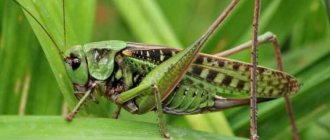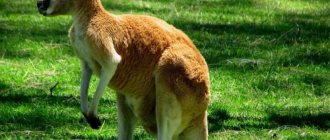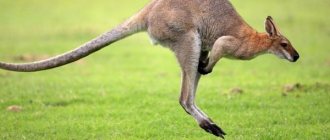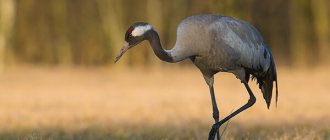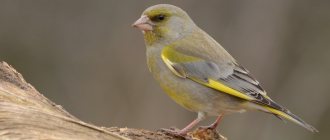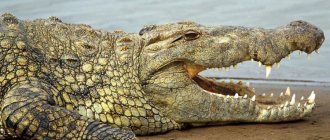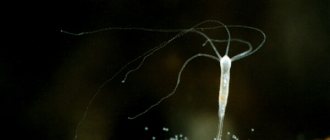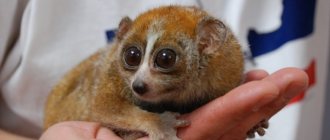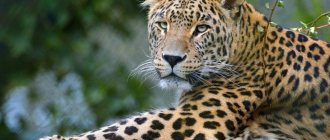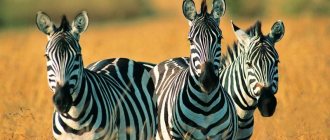Butterfly larva
Butterflies have several stages of development. The adult lays eggs on the underside of a leaf, on the fruits of fruit trees or garden crops, or in another secluded place. After some time, larvae emerge from the eggs - small worms that must consume a lot of food in order to develop and move to another stage.
Butterfly larvae are called caterpillars. The insect can remain in this stage from several days to several years. During this period, the caterpillar actively feeds and often becomes a pest of a plant, eating its fruits, leaves or bark. The larva then forms a cocoon around itself and turns into a pupa. After a certain time, an adult individual emerges from it - an imago, known to everyone as a butterfly.
Interesting!
Butterflies and their caterpillars have a direct size ratio. Large caterpillars are the larvae of large butterflies, and vice versa.
Varieties of caterpillars differ in size, appearance, habitat, but have a common body structure. The body of a butterfly larva consists of several segments:
- a well-defined, rounded head with oral apparatus, visual organs, and horn-shaped antennae;
- breast;
- abdominal region;
- several pairs of limbs.
Caterpillars have several eyes, usually 5-6 pairs located next to each other. The mouth opening is equipped with small teeth for gnawing plants. The body is covered with small hairs and spine-like outgrowths. The caterpillar itself is very mobile and is capable of quickly moving across the surface, hooked with hook-like legs.
Habitat
Most often the caterpillar can be found on the ground, but many representatives have begun to develop under water. For example, the Hawaiian moth caterpillar has spread on land and in water.
Caterpillars are also divided into two types, according to which they lead either a secretive or free lifestyle. Caterpillars, which lead a free lifestyle, live on the foliage of plants and are large in size. Secretive caterpillars include a number of varieties:
- Leafworms. They hide in the curled leaves of various trees.
- Frugivores. Their habitat is limited to tree fruits;
- Drillers. They can only be found inside trees and shoots;
- Miners. These species make special passages in the buds, leaves and petioles;
- Gall formers. They are famous for causing pathology in the growth of damaged plant parts.
Types of caterpillars
Types of caterpillars
Each type of butterfly has its own caterpillar. And the color of the larva does not always coincide with the color scheme of the adult. Caterpillars are mostly herbivorous, but there are also predators. There are four types of caterpillars based on their preference for plant foods:
- polyphagous - those that eat any plants indiscriminately, usually the offspring of moths (wine hawkmoth, ocellated hawkmoth, blind hawkmoth, kaya bear, peacock eye, moths);
- monophages - caterpillars that feed on one specific type of plant (cabbage, silkworm, apple moth);
- oligophages - eat plants belonging to the same family or type (swallowtail, pine cutworm, polyxena);
- xylophagous - larvae that prefer to feed on wood and bark (bark budworm, apple glass beetle, wood borer).
Various types of caterpillars in Russia can live in the subtropical regions of the Caucasus and Krasnodar Territory, and in the northern regions of Siberia. Hundreds of species of these insects are found throughout the country. The names of caterpillar species have a non-random origin. They are usually associated with the pests' main food source. Some caterpillars are named after the pattern on a butterfly's wings.
Valuable rare caterpillars, such as silkworms, are also found in Russia. Silking is a property inherent in all larvae. While moving around the plant, the caterpillar secretes a thin thread using a special spinning tube. This thread serves as insurance for the insect if it accidentally falls from the plant.
Interesting!
The silkworm is a valuable insect. Silk thread is obtained from the butterfly's cocoon, from which silk fabric is produced on an industrial scale.
On the territory of Russia there live small caterpillars, 1 mm in size, as well as giant caterpillars, reaching a length of 12 cm. There are beautiful caterpillars, and there are inconspicuous species, hairy, poisonous, and even changing their color and size during the stage.
The most common and well-known representatives living in Russia include:
- cabbage or cabbage white;
- peacock eye;
- moth (land surveyor);
- clothes moth;
- redtail;
- hawk moth;
- admiral;
- Swallowtail
Moth. Ematurga Atomaria
In nature, there are several species of moth butterflies, and each one has different caterpillars. Some are smooth, and due to their color, they can be mistaken for tree knots.
And there are also unusual caterpillars that, in order to escape from natural enemies, secrete a liquid with which they cover themselves with flower petals. So, it’s quite difficult to see them in the grass.
Such an unusual outfit must always be fresh, so the moth caterpillar often changes its petals to new ones.
9
Cabbage butterfly
Cabbage caterpillar
The caterpillar of the cabbage butterfly is one of the most common in the European part of Russia. The green caterpillar has a body 3-4 cm long, covered with black growths and hairs. She was named after her favorite dish - cabbage leaves. In addition to cabbage, the garden pest also likes to feast on other vegetable crops:
- radish;
- turnip;
- turnip;
- horseradish and others.
The length of time an insect stays in the caterpillar stage depends on weather conditions. This period can range from 2 to 5 weeks. However, even such a short time period is enough for the whitefish to cause serious damage to the crop.
The harpy is big. Cerura Vinula
Due to its unusual appearance, the great harpy caterpillar is called the forktail, due to the unusual appendage at the back of the body.
The completely green caterpillar has a diamond-shaped purple spot on its back, making it one of the most beautiful caterpillars on the planet.
In times of danger, it raises and inflates the front part of the body, and then retracts into the first segment of the body. Fork-shaped processes also serve for protection, from which this amazing creation of nature releases a caustic liquid.
14
Redtail
Redtail caterpillar
The caterpillar is found in the forest-steppe zone of the entire continent, preferring to eat the leaves of various shrubs. The fluffy caterpillars are covered with brown or gray hairs, and the end of their body is painted in a bright scarlet color, the presence of which gave rise to the name of the insects.
On a note!
Redtails also signal with their bright tails that they are poisonous. When this small five-centimeter caterpillar comes into contact with human skin, an allergic reaction occurs.
Silkworm. Bombyx Mori
The silkworm caterpillar made our list more because of its economic importance than its unusual appearance.
But this species also has interesting features that once again confirm the diversity of nature. The fact is that the silkworm caterpillar molts 4 times during its existence, and it lives only from 26 to 32 days.
It feeds exclusively on mulberry leaves, so their habitat is limited to areas where mulberries grow.
12
Swallowtail
Swallowtail butterfly and its caterpillar
A fairly large caterpillar lives in Europe, Asia, North America, and northern Africa. Its color is not inferior in beauty to the appearance of an adult. Photos of the caterpillar clearly demonstrate color changes. At the first stage of its development, the caterpillar is black with bright red spines. Then it becomes striped - green with black stripes, decorated with red spots. The bright swallowtail caterpillar eats various crops:
- carrot;
- parsley;
- celery;
- sagebrush;
- alder.
Slimer. Limacodidae Euclidae
The slug butterfly, which lives in the north of the Australian continent, got its name because of its caterpillar, which looks more like a slug.
It has no legs, and the caterpillar moves like a snail. In addition, they have a very unusual appearance. The bright coloring of the body and unusual horns located on the head and behind the body serve as protection from enemies.
The multi-colored slug caterpillar also protects itself from enemies with the help of poison, which is many times more toxic than wasp poison.
Blind Hawkmoth
Hawkmoth caterpillar
The hawkmoth caterpillar is found in central Russia, Siberia, and the Far East. It feeds on the foliage of birch, poplar, and willow. A green caterpillar with a horn on its tail perfectly camouflages itself as a rolled up tree leaf. Diagonal thin stripes on the body of the larva resemble the veins of leaves. This coloring helps the hawk moth hide from its enemies.
Coquette / Megalopyge opercularis
When you see such a creature in nature, you might not immediately guess that it is a caterpillar. The larva, covered with a kind of fur, looks more like a furry animal. This is the larva of the flannel moth, native to the southern states of the United States.
But it is not recommended to iron it. Under its hairs are poisonous spines that release a toxic substance when touched. The touch is quite painful, and after about five minutes redness may appear.
This feature is necessary for protection. Attentive nature lovers have noticed that the hairy caterpillar bears a striking resemblance to Donald Trump's hair.
2
Peacock eye
Peacock Eye Caterpillar
The beautiful nocturnal butterfly caterpillar is known for its large size - some specimens exceed 10 cm in length. The large green caterpillar of the Peacock's eye lives in the western part of Russia, the Caucasus, and Crimea. The main food is fruit trees:
- Apple tree;
- pear;
- Walnut;
- plum;
- cherry.
On a note!
An interesting feature of the peacock eye is the change in color during the development of the larva. Before pupation, the yellow color changes to green. And the pupa itself turns brown.
Peacock-eye Hercules. Coscinocera Hercules
The caterpillars of these butterflies can reach a record length of 12 cm, which is why they are also called giant caterpillars. According to thebiggest.ru resource, this is one of the largest caterpillars in the world, second in size only to the king nut moth caterpillar.
In addition, they have a very unusual color and body structure. The blue-green caterpillars have reddish spiracles and the entire body is covered with yellow spines.
Of the closest relatives of the Hercules peacock eye, the Chinese and Japanese peacock eye are used to produce silk.
11
Clothes moth
Clothes moth larvae
Clothes moth larvae cause great damage to people's personal belongings. The white caterpillar with a brown head feeds on wool, fur products, and cotton fabric. The female moth lays eggs in closets, pantries, and warehouses where outerwear made from natural materials is stored.
On a note!
The larval stage of the clothes moth can last from one month to two years. The caterpillar is able to go without food for several days and withstand significant temperature changes.
Clothes moth caterpillars are recognized as the smallest - the length of their translucent body varies from 1 to 12 mm. The more food they consume, the longer and thicker they become. The pest lives everywhere in Eurasia, North America, Australia, and some African countries.
Common Dipper / Tyria jacobaeae
This species acquires toxicity as a result of eating a poisonous plant - Jacobea vulgaris. The ability to eat plantings of a poisonous plant is widely used by farmers in Australia and New Zealand to destroy a dangerous weed.
Because of the red coloring of her body, she is also called the Bloody Bear. The caterpillar eats the plant and becomes poisonous itself. They are not dangerous to humans, but pose a threat to birds that eat them.
A small number of these butterflies, and, consequently, caterpillars, were discovered in the Mozhaisk district of the Moscow region. Over the past 40 years, there has been a decline in the number of this butterfly species, which is why many states have adopted laws to protect the species.
By the way, on our website most-beauty.ru there is a fascinating article about the most poisonous and dangerous insects in Australia.
7
Admiral
Caterpillars of the Admiral butterfly
A large, shaggy black-and-orange butterfly that is widespread throughout Russia. It is a migratory insect species. Arriving in more northern regions, it lays eggs on nettle or hop leaves. The admiral winters in the southern regions.
On a note!
Nettles also live on nettle caterpillars similar to admiral larvae.
A small black caterpillar with yellow stripes on the sides appears in May and within a few days creates a kind of canopy around itself from the leaves of the food plant. Throughout the summer it feeds inside its shelter, remaining hidden from predators. At the end of August, the black caterpillar turns into a pupa.
Lonomy. Lonomia Obliqua
Let’s complete our list with an unusual and most poisonous caterpillar that can be found in the forests of Central and South America.
The Lonomiya caterpillar reaches a length of up to 7 cm and lives on tree trunks and branches. Because of its color and fluffy hairs on its body, it is very difficult to notice, but meeting it carries a considerable danger to human health and life.
When touched, the caterpillar releases toxic poison, causing severe burns and swelling. History has recorded cases where contact with Lonomiya led to death.
?
Saturnia Maya / Hemileuca maia
In the photo you can see what the caterpillar of a beautiful butterfly looks like. But the larva disgusts her and discourages her from getting to know each other better.
The entire body is covered with hollow spines, which are connected to poisonous reservoirs. When examined under a microscope, you can see that these spines are covered with multiple hairs. They themselves are dark, but the caterpillar's body is light.
The poison causes severe itching and burning in the victim. After the initial external symptoms, headache and nausea begin. From spring to mid-summer they sit in large groups on oak branches and willows.
13
Baang haang
This is the name of the caterpillars of Thailand. We will complete our list of most-beauty with them. Almost all caterpillars of an exotic country will cause a lot of problems for tourists. After meeting them, the body itches for weeks and a rash appears.
Like many inhabitants of tropical forests, the larvae of Thai butterflies are beautiful and distinctive. Most species are brightly colored to scare off enemies. Some, on the contrary, disguise themselves as foliage or the earth's surface.
When going to any country, you need to study what dangerous creatures you can encounter in its open spaces.
Saturnia io / Automeris io
The beautiful peacock butterfly is found in Canada and the United States. The entire body of the caterpillar of this butterfly is covered with peculiar greenish thorny pom-poms.
She herself is light, and does not grow more than 4–5 cm. You can only admire this view from afar, but under no circumstances pick it up or even touch it. After contact with the thorns, poison penetrates the body. Toxic substances cause redness, pain at the injection site and can even cause the development of dermatitis.
It looks like a very cute and safe creature. But this is yet another proof that beauty is deceptive.
10
